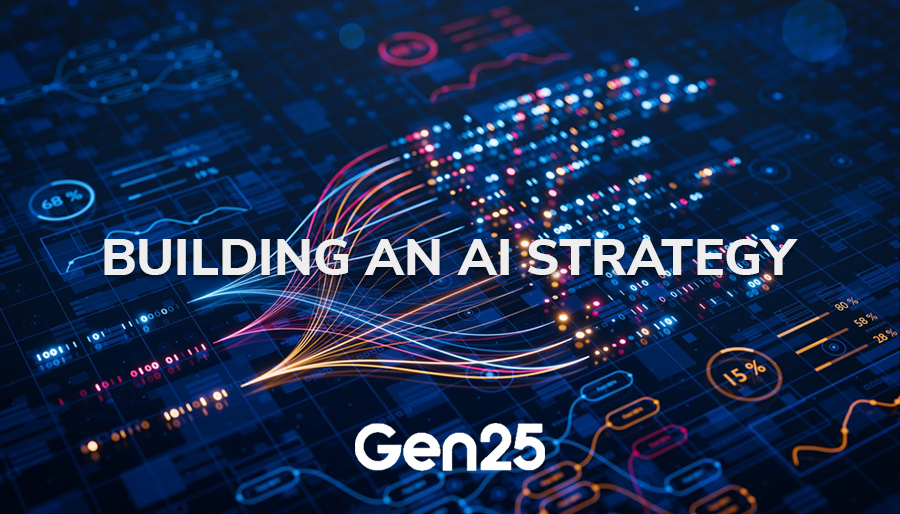Organisaatioiden tehtävänä on nykyään pohtia tekoälyn käyttöönoton lisäksi myös sen tehokasta hyödyntämistä. Vaikka tekoälyn ympärillä oleva innostus on käsinkosketeltavaa, monet yritykset kamppailevat muuttaakseen pyrkimyksensä konkreettiseksi arvoksi. Gen25:n kattava white paper tarjoaa etenemissuunnitelman suurivaikutteisten tekoälysovellusten tunnistamiseen ja onnistuneiden pilottien skaalaamiseen merkittäviksi tuloksiksi. Tämä on olennaista kaikille yrityksille, jotka pyrkivät kehittämään logistiikkatoimintojaan.
Ymmärrys tekoälyn kentästä
Keskustelu yritysten tekoälystä on kehittynyt huomattavasti. Yhä useammat yritykset alkavat ymmärtää tekoälyn integroinnin välttämättömyyden toimintoihinsa ja etsivät käytännön tapoja ottaa käyttöön näitä innovatiivisia työkaluja. Kuitenkin, kun markkinat ovat täynnä teknologiatoimittajien lupauksia, todellinen haaste on tekoälyn hyötyjen toteuttaminen ja samalla kalliiden virheaskelten välttäminen.
Gen25:n white paper tiivistää sen laajan kokemuksen organisaatioista, jotka käyvät läpi merkittävää muutosta, jäsennellyksi strategiaksi tekoälyn toteuttamiseen. Tämä etenemissuunnitelma jakaa tekoälymatkan selkeisiin vaiheisiin, joista jokainen liittyy erillisiin päätöksentekopisteisiin ja toivottuihin liiketoimintatuloksiin. Tämän selkeyden avulla organisaatiot voivat edetä luottavaisesti tutkimuksesta täysimittaiseen toteutukseen.
Liiketoiminnan tarpeiden tunnistaminen
Tehokkaan tekoälystrategian perusta on organisaation tarpeiden syvällinen ymmärtäminen. Tekoälyn käyttöönotossa ei ole kyse sen satunnaisesta soveltamisesta, vaan pikemminkin tiettyjen ongelmien ratkaisemisesta selkeällä käsityksellä odotettavissa olevasta arvosta.
Gen25:n strategia käynnistyy sitouttamalla eri osastojen sidosryhmät tunnistamaan toistuvia haasteita ja tehottomuuksia. Tämän jälkeen jäsennetyt selvitysistunnot auttavat paljastamaan, missä tekoäly voi tuoda suurimman arvon – olipa kyseessä sitten työläiden tehtävien automatisointi, datanäkemyksen saatavuuden parantaminen tai datalähtöisen päätöksenteon tukeminen.
Sen sijaan, että tiimit asettaisivat epämääräisiä tavoitteita, niitä kehotetaan keskittämään huomionsa lupaavimpiin hankkeisiin. Priorisoimalla projekteja niiden potentiaalisen liiketoimintavaikutuksen ja käytännöllisyyden perusteella organisaatiot voivat luoda merkittävää alkuvauhtia ja antaa suuntaa myöhemmille vaiheille.
Oikeiden tekoälytyökalujen valitseminen
Tekoälytyökalujen valtakunta on laaja ja kehittyy nopeasti, mutta kaikki ratkaisut eivät sovellu yrityskäyttöön. Laajan asiakasyhteistyönsä kautta Gen25 on tunnistanut neljä ensisijaista tekoälytyökalujen kategoriaa, jotka tuottavat jatkuvasti arvoa:
- Agentic AI: Tämä luokka tukee tietotyöntekijöitä automatisoimalla rutiinitehtäviä suurten kielimalliavustajien avulla.
- Hakuun perustuva generointi (RAG): Nämä järjestelmät yhdistävät sisäistä dataa generatiivisiin malleihin tarjotakseen tarkkoja ja kontekstitietoisia vastauksia.
- Sulautettu tekoäly: Nämä työkalut integroituvat olemassa oleviin alustoihin, kuten Salesforceen tai Microsoftiin, parantaen toiminnallisuutta ilman suuria häiriöitä.
- Räätälöidyt työkalut: Nämä työkalut on suunniteltu erityisesti vastaamaan erilaisiin liiketoiminnan haasteisiin, ja ne voivat vaihdella asiakirjojen jäsentämisestä asiakaspalautteen tiivistämiseen.
AI-palveluntarjoajien arviointi
Organisaatioilla on useita vaihtoehtoja toteutuskumppaneita etsiessään. Jokaisen mahdollisen ratkaisun arviointi edellyttää keskittymistä käytännön kriteereihin, kuten integraatioyhteensopivuuteen, tietoturvastandardeihin, tukirakenteisiin ja pitkän aikavälin elinkelpoisuuteen. Vaikka jotkut voivatkin päättää kehittää tekoälytyökalun sisäisesti, tämä lähestymistapa vaatii usein huomattavia investointeja – ei vain pääomaa, vaan myös osaamista. Markkinoilla olevien lukuisten työkalujen vuoksi kumppanuus ulkoisen palveluntarjoajan kanssa on usein järkevämpi valinta.
Vahvojen liiketoimintatapauksien muodostaminen
Vakuuttavan liiketoimintatapauksen laatiminen on olennaista minkä tahansa tekoälyimplementoinnin onnistumiselle. Hyvin laaditun liiketoimintatapauksen tulisi olla teknisesti pätevä ja linjassa taloudellisten ja strategisten tavoitteiden kanssa.
Sen tulisi selkeästi ilmaista odotettavissa olevat hyödyt tehokkuudessa, kustannussäästöissä tai liikevaihdon kasvussa, jota tukevat realistiset oletukset ja sidosryhmien panos. Vakuuttava tapaus edistää myös sisäisten tiimien sitoutumista varmistaen, että menestyksen edellyttämät resurssit kohdennetaan.
Strategiasta toimintaan
Pilottiohjelmat toimivat ponnahduslautana siirryttäessä strategisesta suunnittelusta toimintaan. Yleensä tämä matka alkaa konseptin todistamisella, jonka avulla tiimit voivat kokeilla ratkaisuja realistisissa olosuhteissa samalla kun ne vahvistavat oletuksia ja kasvattavat vauhtia.
”Kun pilottihankkeet onnistuvat, teemme yhteistyötä asiakkaiden kanssa laatiaksemme ja toteuttaaksemme yrityksen laajuisia käyttöönottoja”, toteaa Gen25:n johtaja. Näitä laajoja toteutuksia ohjataan tyypillisesti muutosjohtamisstrategioilla, toiminnallisella yhdenmukaisuudella ja keskeisillä suorituskykymittareilla jatkuvan suorituskyvyn arviointia varten. Yleistavoitteena ei ole pelkästään tekoälyn käyttöönotto laajassa mittakaavassa, vaan sen varmistaminen, että se tuottaa kestäviä ja mitattavia tuloksia.
Johtopäätös: Tekoälyn integroinnin tulevaisuus
Gen25:n selvityspaperissa esitetty menetelmä osoittaa, että tekoälytyökalujen onnistunut käyttöönotto edellyttää yrityksiltä liiketoimintatapauksien selkeää määrittelyä, sopivien työkalujen tunnistamista, luotettavien toimittajien valintaa ja liiketoiminnallisen perustelun vahvistamista. Lisäksi, kun tekoäly muokkaa edelleen logistiikka-alaa, organisaatiot voivat hyödyntää tätä vauhtia.
AI:n jatkuvasti laajeneva maisema on kiehtova logistiikan parissa työskenteleville, joille tarkat ja tehokkaat toiminnot ovat ensiarvoisen tärkeitä. Vaikka arvostelut ja palaute ovat korvaamattomia, mikään ei voi korvata omakohtaista kokemusta tästä matkasta. Logistiikan tarpeidesi arviointi GetTransport.comia hyödyntäen varmistaa, että löydät parhaat globaalit kuljetusvaihtoehdot kohtuullisin hinnoin – mikä antaa sinulle mahdollisuuden tehdä tietoisia päätöksiä ylikuluttamatta. Olipa kyseessä muutto kodista tai toimistosta tai suurempien esineiden, kuten huonekalujen tai ajoneuvojen, kuljetus, GetTransport.comin tarjoama mukavuus, kohtuuhintaisuus ja avoimuus tekevät siitä älykkään valinnan kaikkiin kuljetustarpeisiin. Varaa rahtikuljetuksesi GetTransport.comista jo tänään!

 Voittavan tekoälystrategian kehittäminen alusta alkaen">
Voittavan tekoälystrategian kehittäminen alusta alkaen">